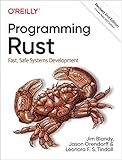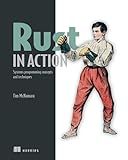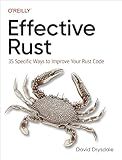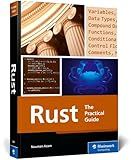Best Rust Programming Books to Buy in January 2026

The Rust Programming Language, 2nd Edition



Programming Rust: Fast, Safe Systems Development



Learn Rust Through Projects: 10 Rust Projects That Teach You Everything



Rust in Action



Effective Rust: 35 Specific Ways to Improve Your Rust Code



Rust Atomics and Locks: Low-Level Concurrency in Practice



Rust Programming: A Practical Guide to Fast, Efficient, and Safe Code with Ownership, Concurrency, and Web Programming (Rheinwerk Computing)


In Rust, traits are a powerful feature that allow you to define shared functionality for different types. You can think of them as interfaces or contracts that a type can implement to ensure it has certain behavior or capabilities.
To create a trait, you use the trait keyword followed by the name of the trait. Inside the trait block, you can define methods and associated types that implementing types must have.
For example, let's create a trait called Printable that requires types to be printable. We can define a single method print that takes self as an argument and prints the value.
trait Printable { fn print(&self); }
To use this trait, you need to implement it for your custom types. Let's say we want to implement Printable for a struct called Person:
struct Person { name: String, age: u32, }
impl Printable for Person { fn print(&self) { println!("Name: {}, Age: {}", self.name, self.age); } }
Now, you can call the print method on Person instances:
fn main() { let person = Person { name: "Alice".to_string(), age: 25, }; person.print(); // Output: Name: Alice, Age: 25 }
Besides methods, traits can also define associated types, which allow you to specify the types associated with the implementing type. For example, a trait can specify an associated type called Output, and each implementing type can define what type it represents.
trait Transform { type Output; fn transform(&self) -> Self::Output; }
Implementing this trait requires defining the associated type and implementing the required methods. Note that associated types are associated with the implementing type, not specific instances.
struct StringTransformer { value: String, }
impl Transform for StringTransformer { type Output = String; fn transform(&self) -> Self::Output { self.value.to_uppercase() } }
Using traits with associated types allows for more flexible and generic programming by abstracting over specific types.
In summary, traits in Rust enable you to define shared functionality across different types, providing a way to enforce consistent behavior and allowing for more generic programming. With traits, you can define methods and associated types that implementing types must have, and then implement the trait for your custom types.
What is the difference between a trait and an abstract class in other languages?
In other languages, like Java, there is a clear distinction between a trait and an abstract class. Here are the key differences:
- Inheritance: An abstract class allows single inheritance, which means a subclass can only extend one abstract class. On the other hand, a class can include multiple traits, allowing for multiple inheritance. This allows more flexibility in code reuse and composition.
- Concrete vs Abstract: An abstract class can have both concrete methods (with implementation details) and abstract methods (without implementation details). Traits, however, can only have abstract methods, meaning they do not contain any implementation details. Traits are primarily used for defining behavior and not for state or data.
- Construction: Abstract classes can have constructors, which are used to initialize the state of the abstract class or its subclasses. Traits, being only a collection of behavior, cannot have constructors.
- Usage: Abstract classes are generally used to create a base class or a blueprint for derived classes, providing some common behavior and characteristics. Traits, on the other hand, are used to add behavior to classes, allowing multiple classes to share the same set of methods without needing to create a common base class.
Overall, while abstract classes focus on creating hierarchies of classes with shared behavior and state, traits focus on defining sets of behavior that can be mixed into different classes independently.
What is the role of associated functions in traits in Rust?
Associated functions in traits are used to define common behavior or functionality that can be provided by multiple types. These functions are associated with the trait itself rather than a specific instance of a type.
The role of associated functions is to provide a way for types implementing the trait to have additional, non-instance-specific functionality that is consistent across all those types. These functions can be called using the trait name itself, without requiring an instance of the type.
Here are some important aspects about associated functions in traits:
- Declaration: Associated functions are declared inside the trait block using the fn keyword and do not have access to the instance of the implementing type.
trait MyTrait { fn my_function(args: Type) -> ReturnType; }
- Implementation: Types that implement the trait can define associated functions as long as they match the function signature declared in the trait.
struct MyType;
impl MyTrait for MyType { fn my_function(args: Type) -> ReturnType { // Implementation } }
- Usage: Associated functions can be called using the trait name followed by :: without requiring an instance of the type.
let result = MyType::my_function(args);
The main benefit of associated functions in traits is that they allow for a unified interface where different types can implement the same functionality without requiring an instance. This promotes code reuse and provides a consistent way to use common functions across multiple types.
How to call an associated function from a trait in Rust?
To call an associated function from a trait in Rust, you can use the trait's name followed by the :: operator and the function's name. Here's an example:
trait MyTrait { fn my_function() -> u32 { // Implementation goes here 42 } }
struct MyStruct;
impl MyTrait for MyStruct {}
fn main() { let result = MyStruct::my_function(); println!("Result: {}", result); }
In this example, the MyTrait trait defines an associated function called my_function. The MyStruct struct implements this trait, which allows it to call the associated function using the :: operator: MyStruct::my_function(). In the main function, we call this associated function and print the result.
What is an associated function in a trait in Rust?
An associated function in a trait in Rust is a function that is associated with the trait itself rather than an individual instance of a type implementing the trait. Associated functions are similar to static methods in other programming languages.
An associated function is defined in a trait using the fn syntax without the self parameter. It can be called using the trait name followed by the :: syntax, without requiring an instance of the type. Rust allows providing a default implementation for an associated function in a trait, and types implementing the trait can choose to override it.
Here's an example of a trait with an associated function:
trait Area { fn calculate_area(&self) -> f64;
fn print\_area\_info() {
println!("This is the Area trait.");
}
}
In this example, the Area trait has an associated function print_area_info() that can be called using the trait name Area::print_area_info(). Types implementing the Area trait will automatically have this function available, but they can choose to override it if needed.
Associated functions are often used in traits to provide utility methods or to define common functionality for types implementing the trait.
